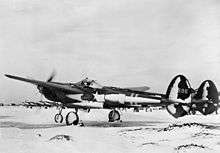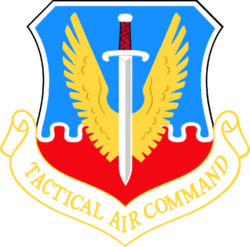342nd Fighter Day Group
| 342nd Fighter Day Group | |
|---|---|
| Active | 1942–1944; 1956 |
| Country | United States |
| Branch | United States Air Force |
| Garrison/HQ | Myrtle Beach AFB |

The 342nd Fighter Day Group is an inactive United States Air Force unit. It was last assigned to the 342nd Fighter-Day Wing, being stationed at Myrtle Beach Air Force Base, South Carolina. The unit was inactivated on 18 November 1956.
History
World War II

The 342nd Composite Group participated in the defense of Iceland by intercepting and destroying some of the German planes that on occasion attempted to attack Iceland or that appeared in that area on reconnaissance missions. The unit also conducted antisubmarine patrols in the North Atlantic and provided cover for convoys on the run to Murmansk, Soviet Union.
The USAAF first engaged enemy forces near Iceland on 28 April 1942 and had been followed by a three months' lull. Then in late July three more encounters took place. Up to this point the honors had gone to the Norwegian patrol squadron, which, under RAF command, was operating off the northern and eastern coast; but it was not long before the American air forces in Iceland had their chances at the Nazis. Having missed being the first to engage the enemy, an American plane became the first to bring one down.
On the morning of 14 August 1942 two American fighter pilots, Lt. E. E. Shahan and Lt. J. D. Shaffer, intercepted and destroyed a Focke-Wulf Fw 200 about ten miles north of Reykjavík. It was the first German plane of the war to be shot down by the Army Air Forces.
During the next two months American fighter planes of the Iceland Base Command bagged two more German planes, intercepted and attacked seven, and unsuccessfully tried to intercept three others. Planes of the Norwegian RAF squadron, meanwhile, had met and attacked three German aircraft with varying degrees of success, and during the same period the ground troops opened fire on German planes a dozen times. A few planes appeared during the winter, but none was intercepted and only two came under antiaircraft fire. Some of this air activity over the North Atlantic was undoubtedly related to the enemy's efforts to set up weather and radio stations in Greenland.
The spring of 1943 promised to be just as lively. In April German planes were spotted or reported on at least ten occasions. One of the intruders, a Junkers Ju 88 bomber, was shot down at the end of the month by two planes of the 50th Fighter Squadron. Throughout the year the number of enemy or unidentified planes reported was about 15 percent less than in 1942. Actual contacts were considerably fewer. Apparently the German planes were successfully avoiding the antiaircraft defenses and evading the American fighters.
On 5 August American planes, making their second interception of the year, shot down another German bomber, the fifth and last enemy plane to be destroyed over Iceland.
After the summer of 1943, little German activity was noted over the North Atlantic skies. The enemy was on the defensive, and the American defensive outposts in the Atlantic (Iceland, Greenland, Newfoundland and Bermuda) were shifting to secondary roles.
The 342nd Composite Group was inactivated on 18 March 1944. Its squadrons were reassigned to England and the Eighth and Ninth Air Forces.
Cold War
On 25 July 1956, the 342nd Fighter Day Group was established and activated at Myrtle Beach AFB, South Carolina.
The group was a placeholder organization directed to reach operational capabilities by overcoming the problems and obstacles inherent in the activation of an organization on a base sill largely under construction. Close liaison was maintained between units at Shaw AFB, SC for many activities. There were regularly scheduled truck convoys between Shaw and Myrtle Beach during the Wing's development.
The 342 FDG lasted 117 days until 18 November 1956. On 19 November, the Air Force redesignated the unit as the 354th Fighter-Day Group, absorbing all personnel and assets of the organization, with the 33d FS becoming the 353d Fighter Squadron; the 572d FS becoming the 355th Fighter Squadron*, and 573d FS becoming the 356th Fighter Squadron*.
* Note: redesignated only, not equipped or manned until 19 November 1956
Lineage
- Constituted as 342nd Composite Group on 29 August 1942
- Activated on 11 September 1942
- Disbanded on 18 March 1944
- Established as 342nd Fighter Day Group on 25 July 1956 and activated
- Inactivated with personnel and equipment being redesignated as 354th Fighter-Day Group on 18 November 1956
Assignments
- Iceland Base Command, 11 September 1942 – 18 March 1944
- 342nd Fighter-Day Wing, 25 July 1956 – 18 November 1956
Components
- 33d Fighter Squadron, 11 September 1942 – 18 March 1944; 25 July – 19 November 1956
- 50th Fighter Squadron, 14 November 1942 – 1 February 1944
- 337th Fighter Squadron, 11 September – 26 November 1942
- 572d Fighter Squadron, 25 July – 19 November 1956*
- 573d Fighter Squadron, 25 July – 19 November 1956*
*Note: Never officially activated, manned or equipped
Stations
- Keflavik, Iceland 29 August 1942 – 18 March 1944
- Myrtle Beach Air Force Base, South Carolina, 25 July – 18 November 1956
Aircraft Assigned
- P-38 Lightning (1942–1944)
- P-39 Airacobra (1942–1944)
- Curtiss P-40 (1942–1944)
- B-18 Bolo (1942–1944)
- RF-80 Shooting Star (1956)
References
![]() This article incorporates public domain material from the Air Force Historical Research Agency website http://www.afhra.af.mil/.
This article incorporates public domain material from the Air Force Historical Research Agency website http://www.afhra.af.mil/.
- Maurer, Maurer (1983). Air Force Combat Units Of World War II. Maxwell AFB, Alabama: Office of Air Force History. ISBN 0-89201-092-4.
- History of the 342nd Fighter Day Wing, 354th TFW Office of History, Myrtle Beach Air Force Base, 1956 (USAFHRA Microfilm Record)
- The North Atlantic Bases in Wartime
